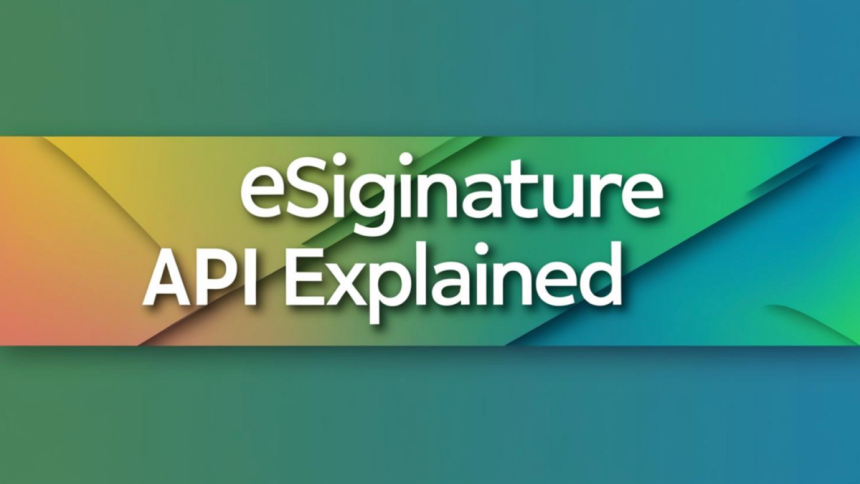Businesses are continually seeking ways to streamline operations, enhance security, and improve user experiences. One significant advancement aiding these objectives is the use of digital signature solution. These solutions come up with thier own api integrations that enable organizations to embed electronic signing capabilities directly into their applications and workflows, revolutionizing how agreements are executed and managed.
A study by MarketsandMarkets predicts that the global eSignature market will reach $14.1 billion by 2026, driven by demand for faster, paperless transactions and remote collaboration. Organizations across industries, including finance, healthcare, legal, and real estate, are adopting eSignature APIs to optimize their contract management processes.
Understanding eSignature APIs
An eSignature API is a set of protocols and tools that allows developers to incorporate digital signature functionalities into software applications seamlessly. Unlike traditional signatures, which necessitate physical presence and paper documents, eSignatures are executed electronically, offering a more streamlined and efficient process.
Key Differences Between eSignatures and Traditional Signatures:
- Accessibility: eSignatures can be executed from anywhere with an internet connection, eliminating the need for physical document exchange.
- Speed: Digital signing accelerates the approval and execution of documents, reducing turnaround times from days to minutes.
- Cost-Effectiveness: By minimizing paper usage and reducing the need for physical storage, eSignatures help organizations cut operational costs.
- Security: eSignatures incorporate advanced encryption and authentication measures, ensuring the integrity and authenticity of signed documents.
Why Businesses Need eSignature APIs
1. Streamlining Workflows
- Automation: eSignature APIs automate the signing process, reducing manual intervention and speeding up transactions.
- Integration: They can be seamlessly integrated with existing business applications such as CRM systems, ERP software, and document management platforms, creating a cohesive workflow.
- Faster Approval Cycles: Reduces approval times by up to 80% compared to traditional signing methods.
2. Enhancing Security and Compliance
- Data Protection: eSignature APIs employ robust encryption standards to protect sensitive information during transmission and storage.
- Regulatory Compliance: They help businesses adhere to legal standards and industry regulations, such as the ESIGN Act, eIDAS, UETA, HIPAA, and FINRA, ensuring that digital signatures are legally binding and recognized.
- Tamper-Proof Audit Trails: Every signature action is recorded, making it easier to verify authenticity and prevent fraud.
3. Improving Customer Experience
- Convenience: Clients and partners can sign documents at their convenience without the need for physical meetings or postal services.
- Transparency: Real-time tracking and notifications keep all parties informed about the status of documents, enhancing trust and transparency.
- Mobile-Friendly Signing: Supports electronic signatures on smartphones, tablets, and laptops, improving accessibility.
4. Environmental Impact
- Sustainability: By reducing reliance on paper, eSignature APIs contribute to environmentally friendly business practices, aligning with corporate sustainability goals.
- Paperless Efficiency: Businesses that go paperless save an average of $20 per document in processing costs.
Key Features of a Robust eSignature API
When selecting an eSignature API, it’s essential to consider features that will best support your business needs and ensure seamless integration. A robust eSignature API should offer:
- Ease of Integration: The API should be designed with flexibility in mind, allowing it to integrate with a wide range of systems with minimal effort.
- Automated Workflows: The API should enable the automation of document workflows, reducing manual intervention and speeding up processes like contract approvals and employee onboarding.
- Security and Compliance: The API should ensure that all digital signatures are secure, legally binding, and compliant with industry standards, including ISO 27001 and SSAE SOC II Type 2.
- Scalability: Whether you’re a small business or a large enterprise, the API should be able to scale to meet your needs, ensuring that your digital signature solution grows with your business.
- Custom Branding: Allows businesses to maintain brand consistency while offering digital signing experiences within their own applications.
Industry Use Cases for eSignature APIs
1. Financial Services & Banking
- Automates loan applications, mortgage approvals, and wealth management agreements.
- Ensures compliance with financial regulations like FINRA, KYC, and AML laws.
- Reduces fraud risks and accelerates approval cycles.
2. Healthcare & Life Sciences
- HIPAA-compliant digital signatures for patient consent forms and medical records.
- Speeds up clinical trial approvals and pharmaceutical agreements.
- Enhances security and reduces paperwork-related errors by 60%.
3. Legal & Contract Management
- Automates contract signing for NDAs, MSAs, and sales agreements.
- Tamper-proof audit logs ensure document integrity and legal compliance.
- Reduces legal processing times by 40%.
4. Real Estate & Property Management
- Simplifies lease agreements, tenant onboarding, and mortgage approvals.
- Prevents fraud in high-value real estate transactions.
- Agents using eSignatures close deals 25% faster.
5. Human Resources & Employee Onboarding
- Automates employment contracts, tax forms, and offer letters.
- Eliminates paperwork bottlenecks and improves hiring efficiency.
- Reduces HR processing times by 70%.
How to Successfully Implement an eSignature API
1. Assess Organizational Needs
- Evaluate your current document workflows to identify areas that would benefit from digital signatures.
- Identify compliance requirements for your industry.
2. Choose the Right API Provider
- Select a provider that offers robust features, security, and compliance with industry standards.
- Look for APIs that support seamless integration with your existing applications.
3. Plan for Integration & Customization
- Ensure that the API can be embedded into your CRM, ERP, HRMS, and contract management systems.
- Use API documentation and SDKs to tailor the solution to your business needs.
4. Train Staff & Onboard Users
- Provide training to employees to ensure they are comfortable using the new system.
- Offer customer support to partners and clients using your eSignature platform.
5. Monitor & Optimize
- Regularly review the system’s performance and make necessary adjustments to optimize efficiency.
- Analyze usage data to improve adoption rates and user experience.
Conclusion
The integration of eSignature APIs into business operations is no longer a luxury but a necessity in today’s digital age. They offer a multitude of benefits, including streamlined workflows, enhanced security, improved customer experiences, and cost savings. By adopting eSignature APIs, businesses can stay competitive, comply with evolving regulations, and meet the growing expectations of clients and partners.
As the business landscape continues to evolve, embracing digital solutions like eSignature APIs will be crucial for organizations aiming to maintain efficiency, security, and customer satisfaction. The future of business transactions is digital, and eSignature APIs are at the forefront of this transformation.
Ready to integrate a secure, enterprise-grade eSignature API? Get started with Certinal and transform your document workflows today!
Lynn Martelli is an editor at Readability. She received her MFA in Creative Writing from Antioch University and has worked as an editor for over 10 years. Lynn has edited a wide variety of books, including fiction, non-fiction, memoirs, and more. In her free time, Lynn enjoys reading, writing, and spending time with her family and friends.















